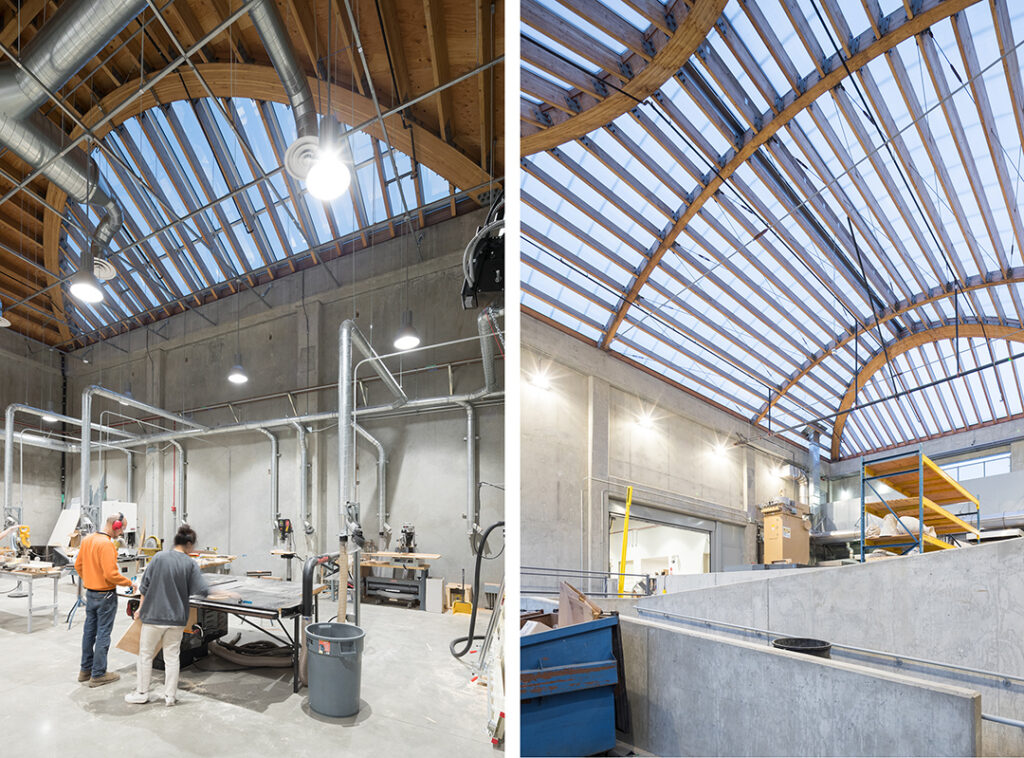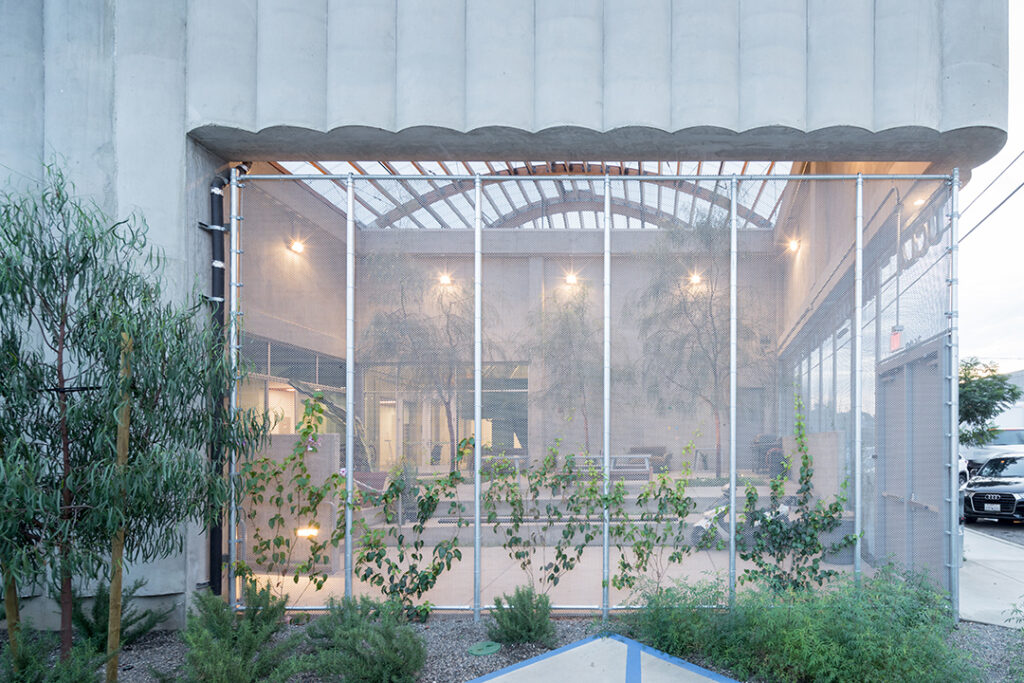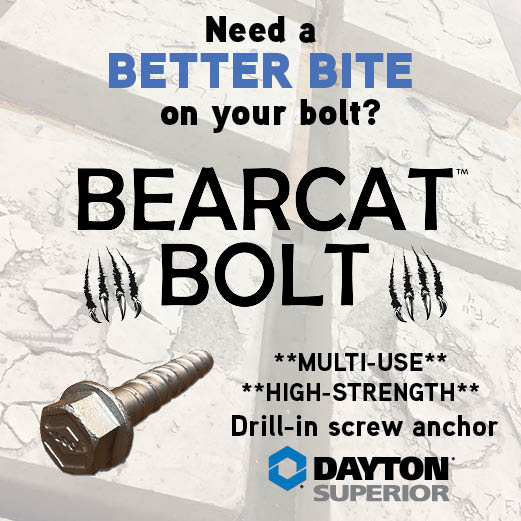Tilt-Up En Vogue In The Hayden Tract
text by Mitch Bloomquist
photos by Iwan Baan
Español | Translation Sponsored by TCA
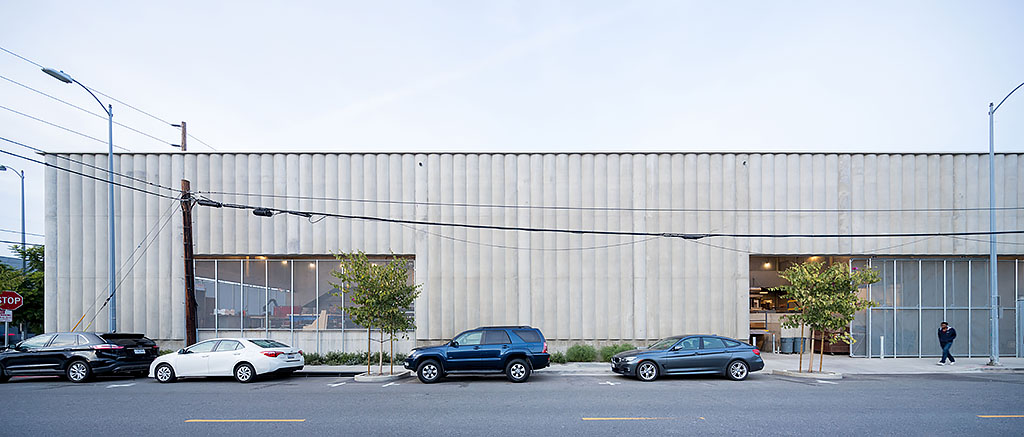
“Look around, and it is clear that tilt-up is having a moment, and with the design for the new Margo Leavin Graduate Art Studios at the University of California, Los Angeles, Johnston Marklee is proving that the humble material is anything but staid.”
— Katie Gerfen, editor of design for ARCHITECT.
On the west side of Los Angeles, close to Venice and LAX in Culver City, exists an area known as Hayden Tract. It is home to formerly abandoned industrial warehouses converted into a vibrant community of studios and offices. Interwoven throughout the area is a famous collection of offbeat architectural interventions designed by Eric Owen Moss. Named “Conjunctive Points,” the series is considered a laboratory for architectural innovation and enlightened development. The newest conversion/addition to the neighborhood is the Johnston Marklee-designed UCLA Margo Leavin Graduate Art Studios.
Ad Hoc Adaptation
It was in the mid-1980s that UCLA moved its graduate art studios off campus to a former wallpaper factory located in the then-industrial section of Culver City. The rudimentary concrete structure met the department’s spatial needs economically and also provided the sort of blank space and independence the arts program was seeking. The original corner structure, built in 1948, features classic wood bowstring trusses and virtually indestructible concrete bones. Surrounding the building, thanks to its generous street setbacks originally accommodating loading-dock activities, was a two-story concrete masonry office building, a second bowstring truss building, and an accumulation of small sheds and shipping containers students commandeered as woodshops and spray booths. “To say the place was adapted ad hoc,” says UCLA principal project manager John D’Amico, “is to put it nicely.” This, coupled with a total lack of modern updates (like climate control, fire protection, or accessibility) prompted the university to issue an RFP in 2010 for an overhaul. The project sat idle until UCLA alumna and legendary figure on Los Angeles’s art scene, Margo Leavin, gave $20 million for the project in 2016.
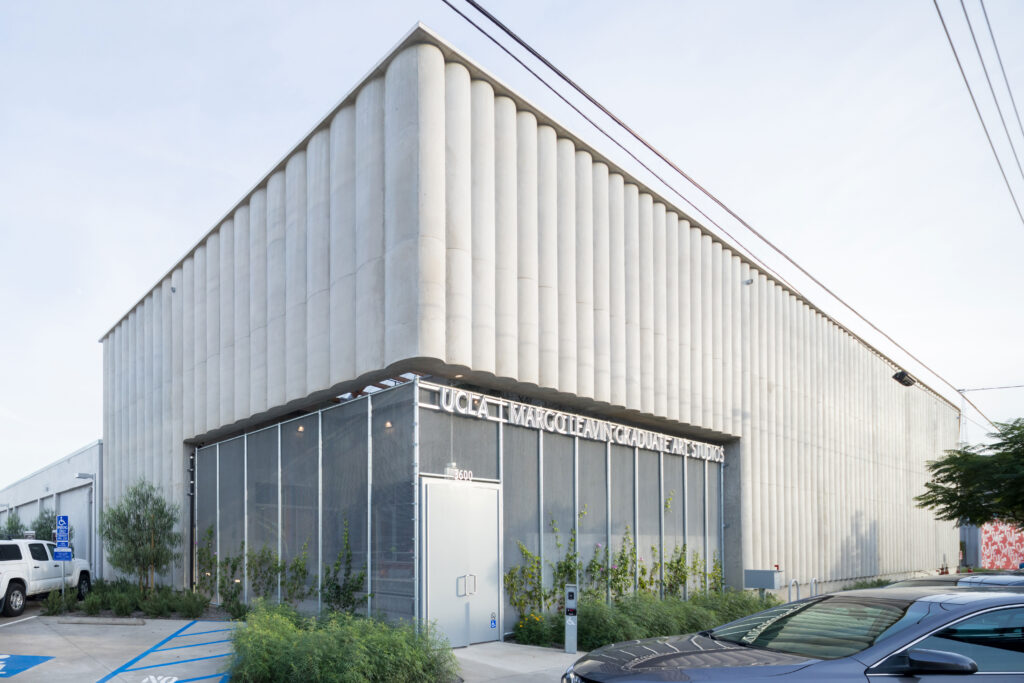
Despite the structure’s inadequacies as outlined in the RFP, Sharon Johnston FAIA, Founder and Partner with Johnston Marklee, explained that the design team came to understand the students’ affinity for the existing space and aimed to conserve many of the qualities they were so endeared to. A key conceptual question, said Johnston, was “how to create a state-of-the-art MFA facility without erasing the original spirit and culture.”
Curbing Evident Design
Their scheme is an L-shaped addition wrapping the building, replacing the assemblage of shacks and other additions. Six volumes, each housing different programmatic elements, alternate between conditioned and nonconditioned space. Each new volume receives light and air from above. Glulam vaults enclosed in translucent polycarbonate bring an abundance of natural light to the nonconditioned spaces, while the insulated roof over the conditioned spaces gives way to expansive glass ends that have light-responsive, self-darkening features where needed. In contrast to these light, open assemblies, which were inspired by the original bowstring trusses (now restored and reinforced), the structure and façade of the building are much quieter, stoic and enclosed.
While the design team certainly considered and admired the quirky neighboring works by Eric Owen Moss, they more closely attended to the broader architectural heritage of the surrounding Hayden Tract and beyond.
“We look at a building not only as a single building, but in a larger context,” said Mark Lee, Founder and Partner with Johnston Marklee. “We see our building as part of reinforcing that existing context, that his [Moss’s] work actually stands out more.” Furthermore, they felt the students would be better served by a more subtle utilitarian approach. “Many of the students didn’t want a new building,” Johnston said. “They really love the sort of rawness, almost decaying quality of the existing building. And so too much evident design would, in a way, counter the creative programmatic mission of the building.”
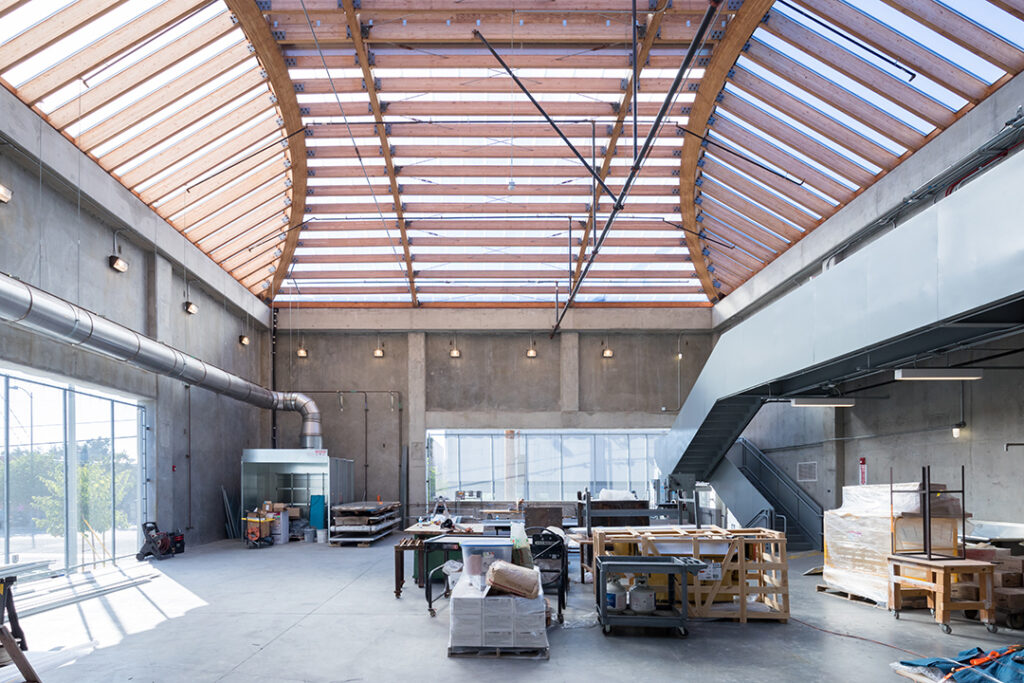
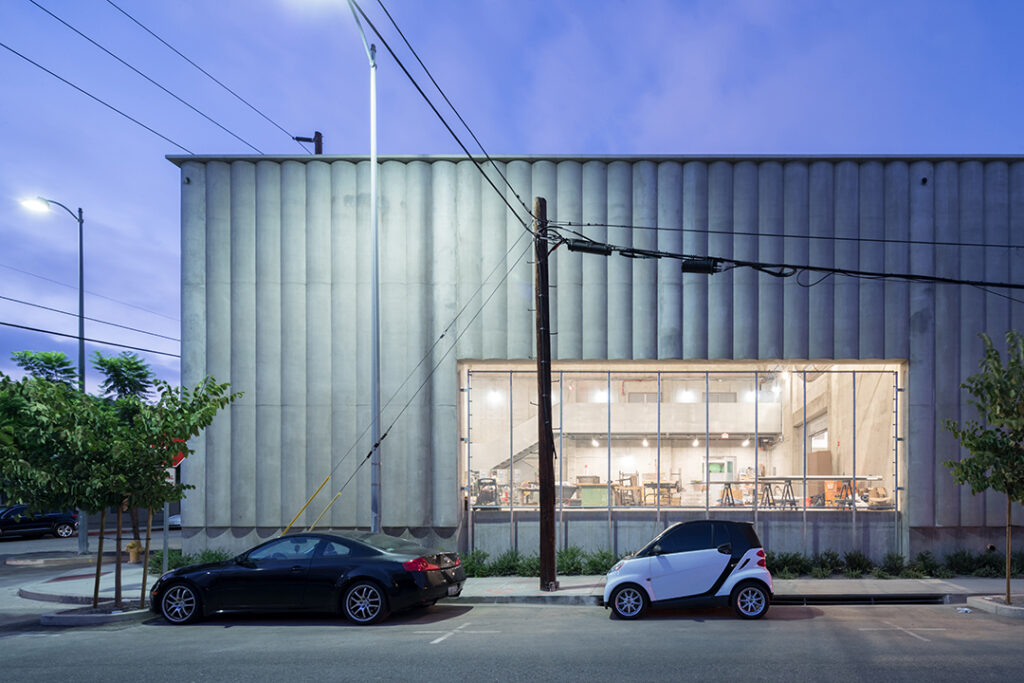
Technology as Architectural Heritage
Johnston Marklee’s efforts to associate with this architectural heritage are not solely through visual means. Through their employment of tilt-up construction, they are connecting through technology as well. While the 1948 factory was cast-in-place concrete, Johnston said, “we wanted to harken back to the tilt-up vernacular, found here and elsewhere in LA.”
They added their own twist though. Considering the economy tilt-up provides for manipulation of the walls’ face, Johnston Marklee cast vertical columnar reliefs in the panels. Frances Anderton, host of DnA: Design and Architecture, a radio show broadcast on the KCRW NPR station in Los Angeles, said in a podcast interview with Johnston Marklee that the texture was like fat corduroy. Gerfen describes the panels as a nod to warehouse construction, but elevated with a “lush, almost textile-like finish.”
When compared with other methods of construction, tilt-up is able to incorporate substantial complexity without much in the way of added cost. This is becoming a more well-known fact with leading-edge architects. “It’s a bit in vouge, I think,” said Anderton regarding tilt-up concrete. “It’s kind of made a comeback.”
Innovative Building Systems and Elemental Materials
The pillowed articulation of the exterior face was accomplished efficiently with tilt-up construction, as panels were formed and concrete was placed horizontally, allowing for access to the wall’s face and to already existing support for the formliner in the building slab.
Each pillow is 2 feet in width and extends 4 inches from the otherwise 10-inch-thick wall panel. The thickness of the elements is not purely structural; it eliminates the need for waterproofing and insulating. Sustainable strategies were considered fundamental for the project, which is seeking LEED Gold certification. Johnston Marklee’s approach is to deliver a holistic and efficient structure through innovative building systems and distilled materials over the application of layers of sustainable technology products.
“The approach was economical (within the $23.2 million construction budget) and sustainable (reducing heavy-materials transport in a project poised for LEED Gold certification),” writes Sarah Amelar in Architectural Record. “It was also time-effective, meeting the inflexible first-day-of-school opening date of September 30. But tight site conditions and such obstacles as power lines made the method challenging.”
Zero-Lot Lines and Tight Tolerances
According to Dave Tennis, Vice President at Largo Concrete Inc., the site and project indeed presented some challenges; but for them, they were the types of challenges that attracted them to the job in the first place.
As with any tilt-up job, crane access had to be ironed out early. With zero-lot lines, complex elevation changes, and some overhead obstacles, it was clear that the building slab would have to allow for crane access. This limited the amount of space that could be dedicated to panel layout.
Fitzgerald Formliners fabricated the custom formwork for the signature concrete pillows (or pillars) just outside of Los Angeles. While not originally specified, Fitzgerald was able to cut the lead time in half, from approximately 24 weeks to 12 weeks.
Of greatest concern was the tight tolerances required to accomplish Johnston Marklee’s vision. To ensure proper and uniform fit and form, Fitzgerald first wire-cut expanded polystyrene (EPS) foam blanks at 2 feet by 10 feet by 6 inches, ensuring accuracy using precision jigs. The blanks were then fashioned again using a wire to receive their arched shape. To improve the durability of the form, and to provide a smooth surface for casting, the foam was then covered with a laser cut 1/8-inch-thick sheet of high-impact polystyrene.
So that each element would butt together seamlessly, the arching polystyrene caps were slightly oversized and then trimmed, again with the use of a precision jig, so that the edge terminated in line with the EPS ninety degrees from the slab. Before leaving the shop, each unit was inspected and checked against a master unit to once again confirm dimensions and seamless fit, ensuring no issues in the field.
Tennis said that the form liner units fit perfectly into their tilt-up panel forms. The same form liner units were also used to form the exterior of cast-in-place columns between tilt-wall panels to achieve the final uninterrupted rhythm.
Tilt-Up Without a Diaphragm
Seismic forces coupled with strong architectural direction calls for engineering creativity. This generated some unique details not common on most tilt-up projects. For starters, the panels along each elevation were tied together via cast-in-place stitch columns. Kevin D. O’Connell, S.E. principal with Simpson Gumpertz & Heger, explained that this design preforms better for seismic zones, as it consolidates panels to resist overturning forces at the corners, or ends of the walls, improving building performance and simplifying the foundation design. To make the connection, the tilt-up walls were cast with form savers to allow horizontal reinforcement continuity without protruding bars, which would have complicated the column reinforcement construction. Once the panels were erected, bars were inserted into the form savers and tied into the column reinforcing.
Another atypical detail involves the sleek vaulted glulam roof structure, which adds tremendous brightness and airiness to the space, but offers little in the way of out-of-plane bracing for the walls. Typical tilt-up structures call upon a roof diaphragm to transfer out-of-plane loads on walls to perpendicular concrete walls. For this application, O’Connell instead employed a continuous cast-in-place, horizontally spanning ring-beam, which was supported by the columns, to transfer loads to perpendicular concrete walls. Much of the specific detailing here was made visible only from the interior, so as to preserve the exterior architectural appearance.
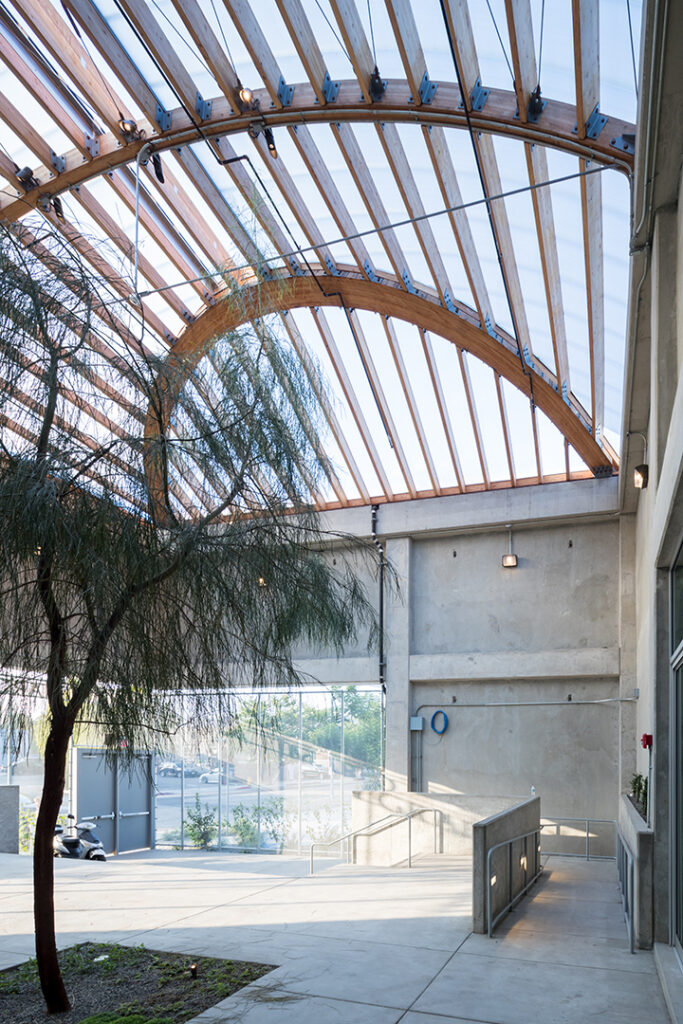
A Blank Canvas
The building’s interior is remarkably raw and simple in appearance. Great thought and careful planning allowed for the elimination of any exposed embedded structural plates in the concrete. The walls, columns and ring beam come together without visible hardware (except for the exposed lifting inserts, which tell the story of its assembly). The result is a shell that, as the original cast-in-place structure, looks indestructible, raw and bare. It is like a blank sheet of paper.
Conduit, lighting fixtures, HVAC equipment and other building systems are surface-mounted and exposed as if they could be reconfigured at any moment. Interior partitions are treated similarly with future flexibility as an obvious priority.
Anderton shared some of the students’ reactions in her podcast.
“They didn’t overproduce the space. The material lends itself to feeling comfortable in making mistakes. You can see all of the framing. You can imagine that the studio walls can be rebuilt if necessary,” said Jane Orr.
“One of my biggest fears when I walked into this building for the first time was like, ‘Are we going to be able to live and function as artists within the space?’ And the answer is yes.”
